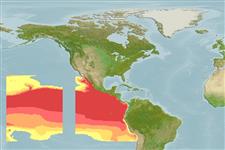Common names from other countries
>
Beryciformes (Sawbellies) >
Melamphaidae (Bigscale fishes or ridgeheads)
Etymology: Melamphaes: Greek, melan, -anos = black + Greek, amphi = both side (Ref. 45335).
Environment: milieu / climate zone / depth range / distribution range
Ecologia
marinhas batipelágico; intervalo de profundidade 62 - 500 m (Ref. 51657). Deep-water; 30°N - 23°S, 120°W - 130°W (Ref. 87970)
Eastern Pacific Ocean: tropical, endemic to ETP, from the California coast (ca. 30°N) down to northern Chilean coast (ca. 23°S).
Tamanho / Peso / Idade
Maturity: Lm ? range ? - ? cm
Max length : 12.8 cm SL macho/indeterminado; (Ref. 87970)
Descrição breve
Chaves de identificação | Morfologia | Morfometria
Espinhos dorsais (total) : 3; Raios dorsais moles (total) : 13 - 16; Espinhos anais: 1; Raios anais moles: 8; Vértebras: 27 - 28. The species is characterized by the following: large head (more than 40% of SL, specimens of SL ? 100.0 mm); first gill arch with 20-22 rakers; total vertebrae 26-28, 11 abdominal; haemal arch of the first caudal vertebra is without a spur; D III,13-16; P14-15; ventral fin with 7 soft rays; ventral fin starts before the vertical line of the posterior margin of the pectoral fin basement; anal fin starts under the vertical line of the 3-4 ray of the dorsal fin (posterior end); operculum with 4 scales (Ref. 87970).
Adults caught below 400-500 meters; juveniles in shallower water (Ref. 51657). Specimens were sampled by open-mouth nets at depth range of 1500-0 m; the minimal sampling depth was 62 m (individuals with SL = 12.7-13.3 mm) (Ref. 87970).
Life cycle and mating behavior
Maturities | Reprodução | Spawnings | Egg(s) | Fecundities | Larvas
Kotlyar, A.N., 2011. Revision of genus Melamphaes (Melamphaidae). II. Multi-raker species: M. polylepis, M. falsidicus sp. nova, M. pachystomus sp. nova, M. macrocephalus, M. leprus. J. Ichthyol. 51(8):658-661. (Ref. 87970)
Categoria na Lista Vermelha da IUCN (Ref. 130435)
CITES (Ref. 128078)
Not Evaluated
Ameaça para o homem
Harmless
Utilização humana
Ferramentas
Relatórios especiais
Descarregue XML
Fontes da internet
Estimates based on models
Preferred temperature (Ref.
115969): 12.1 - 14.8, mean 13.2 (based on 26 cells).
Phylogenetic diversity index (Ref.
82804): PD
50 = 0.5000 [Uniqueness, from 0.5 = low to 2.0 = high].
Bayesian length-weight: a=0.01096 (0.00451 - 0.02668), b=3.10 (2.89 - 3.31), in cm Total Length, based on LWR estimates for this (Sub)family-body shape (Ref.
93245).
Nível Trófico (Ref.
69278): 3.7 ±0.2 se; based on size and trophs of closest relatives
Resiliência (Ref.
120179): Baixo, tempo mínimo de duplicação da população 4,5 - 14 anos (Preliminary K or Fecundity.).
Fishing Vulnerability (Ref.
59153): Low vulnerability (10 of 100).
